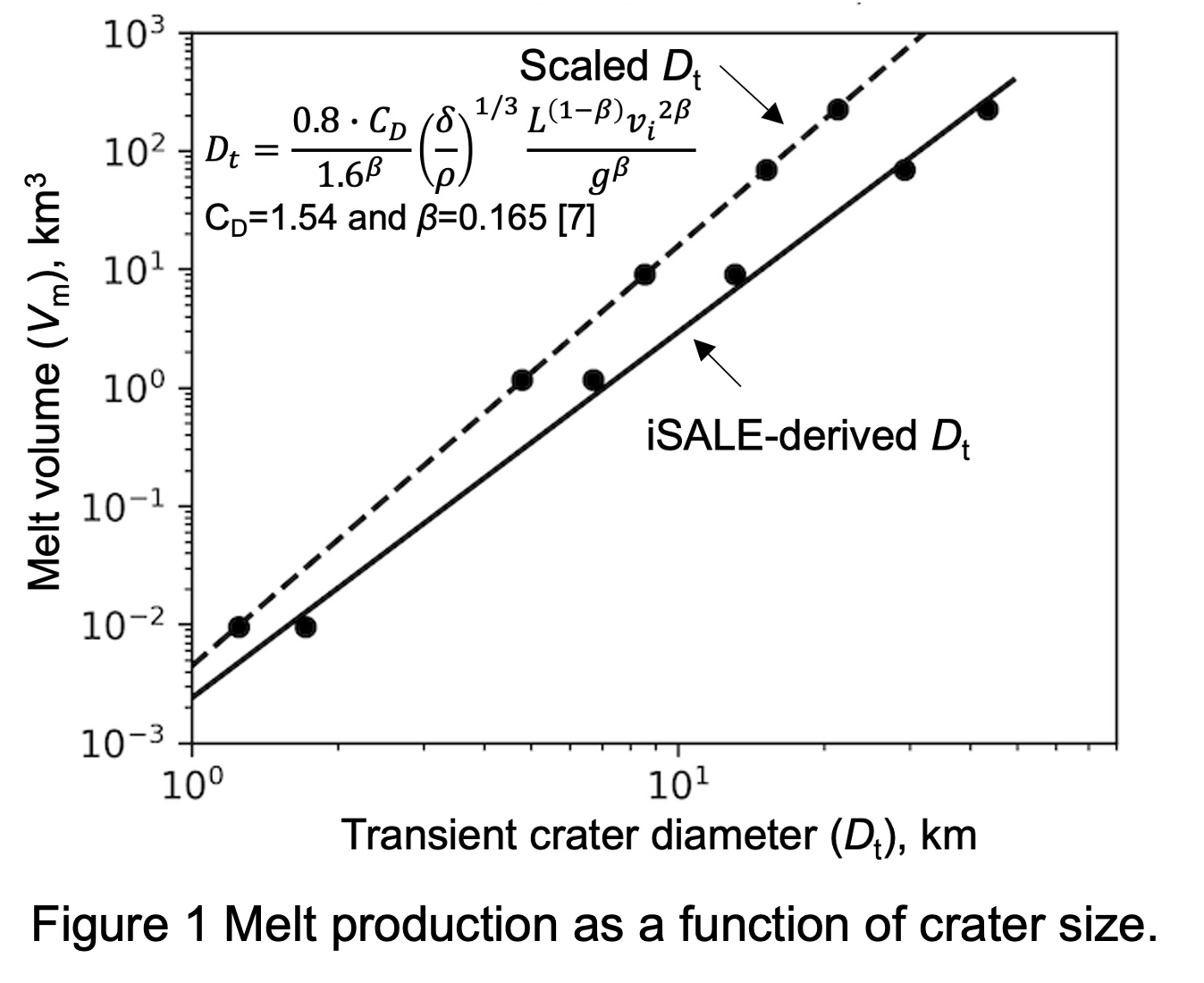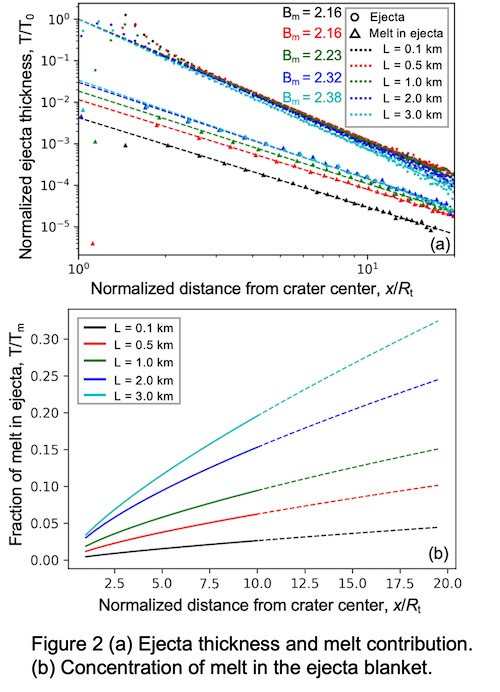Melt production and ejection at lunar intermediate-sized impact craters: where is the molten material deposited?
- 1Museum für Naturkunde Berlin, Leibniz Institute for Evolution and Biodiversity Science, Germany
- 2Freie Universität Berlin, Germany
1. Introduction
Impact melt rocks are the only lunar sample material that allows for absolute dating of impact events. Therefore, these samples are key to unveiling the early bombardment history of the Moon. However, due to the mixing of melt products ejected from distant craters, the interpretations of lunar samples are difficult [1]. Here, we use the iSALE2D shock physics code to quantify the production of impact-induced melt and especially its distribution in ejecta blankets for lunar craters of intermediate size (1.5 – 50 km in diameter).
2. Methods
We carried out a suite of iSALE simulations with varying projectiles diameter from 100 m to 3 km. We use an analytic equation of state for basalt to describe the thermo-dynamical behavior of the lunar crust (cf. [2]). Material strength, damage, and porosity were accounted for using the models of [3], [4], and [5, 6], respectively. Due to the long-term impact fragmentations, the lunar near-surface lithologies are assumed to be porous. The presence of porosity enhances melt production [7]. We set the porosity profile following the exponential function of [8] that best matches gravity data.
To investigate melt production sufficiently high resolution in the models is required. At the same time simulations of the entire ejection process are only possible at coarser resolution. To reach a good compromise for the computational costs in terms of spatial resolution, computation time, and accuracy to quantify melt production and deposition upon ejection, we apply a 3-step approach for simulations:
Models to determine impact-induced melts. To quantify melt production, we first determine the critical shock pressure Pc where the post-shock final temperature exceeds the melt temperature as a function of porosity. Impact-induced melts are generated if the material experiences peak shock pressures (Ppeak) in excess of Pc. We use Lagrangian tracers to record Ppeak during the passage of the shock wave. The average impact velocity of 18 km/s on the Moon is kept constant. We use a high resolution of 40 cells per projectile radius (CPPR) to model the early stage of impact processes until the shock wave has attenuated below Ppeak.
Models to analyze ejecta deposit. Lagrangian tracer particles are also used to track ejected materials. Tracers are considered to be ejected when they reach the altitude of one projectile radius above the surface. We extrapolate the trajectory back to the surface and record the launch position. The cumulative number of tracers deposited at a given distance allows for determining the thickness of the ejecta blanket. In these models, the normal component of impact speed for the most likely impact on the Moon (45°) is considered (i.e., 13 km/s). Given that 10 CPPR is often sufficient to simulate crater growth [7], 10 CPPR is taken for these models, and they run until the crater reaches the maximum volume, which is assumed to be a good approximation for the transient craters when the ejection process has ceased.
Combining data of impact-induced melt and ejection. Typically, each cell in iSALE models is assigned a single tracer. For better analysis, we make the positions of tracers in 10 CPPR-models exactly the same as those in the 40 CPPR-models by putting 16 uniformly distributed tracers in each cell. To estimate melt distribution in ejecta, Ppeak of the ejected tracers derived from 10-CPPR models is revised by replacing it with that from 40-CPPR models.
3. Production of impact-induced melt
The volume of impact melt (Vm) increases exponentially with the increasing diameter of transient craters (Dt): Vm = cDtd. Our results (Figure 1) present a more gentle slope (d = 3.09; c = 2.37×10-3) than the analytical value (d = 3.8, [9]) when Dt is directly taken from iSALE models. This is partially caused by the decreasing influence of the porosity gradient with increasing projectile size and is also related to the determination of Dt. After the model-derived Dt is replaced with the scaled Dt. The results present an exponent d = 3.55 (c = 4.41×10-3).

4. Ejection of impact-induced melt
A power law expression for the ejecta thickness (T) as a function of landing distance (r) was formulated: T(r)=T0(r/Rt)-B, where Rt is the transient crater radius as derived with iSALE. As shown in Figure 2, T decreases with distance according to a power-law with an exponent of ~ -3.0, which is consistent with the laboratory experiments and the observation of lunar ejecta blankets.
We calculate the thickness of a hypothetical “melt blanket” (Tm), which only consists of impact-induced melt material. We use the same way as we calculate the total thickness of the ejecta blanket, but consider only the materials that are molten. The results (Figure 2) show that Tm is also a function of landing distance following a power law: Tm(r)=Tm0(r⁄Rt)-Bm. Tm is decreasing with the distance from the crater center, but the slope of the “melt blanket” is more gentle than that of the total blanket and has an exponent of around -2.3. In addition, even though the thickness of both the ejecta and the melt blanket decreases with distance from the crater center, the concentration of impact melt in the ejecta blanket increases.

5. Conclusions
We found the production of impact-induced melt is a function of transient crater size following a power law. But due to the decreasing porosity gradient with depth, the melt production for small craters is more significantly enhanced compared with that of larger craters leading to a gentler slope. In addition, the melt concentration within the blanket is almost linearly increasing. It indicates that impact melt is highly concentrated not only inside the crater but also in the most distal ejecta.
References:
[1] Kring and Cohen (2002) JGR. [2] Pierazzo+ (2005), Large Meteorite Impacts III. [3] Collins+ (2004) MPS. [4] Ivanov+ (1997) International Journal of Impact Engineering. [5] Wünnemann+ (2006) Icarus. [6] Collins+ (2011) International Journal of Impact Engineering. [7] Wünnemann+ (2008) EPSL. [8] Besserer+ (2014) GRL. [9] Cintala and Grieve (1998) MPS.
How to cite: Liu, T., Luther, R., Manske, L., and Wünnemann, K.: Melt production and ejection at lunar intermediate-sized impact craters: where is the molten material deposited? , Europlanet Science Congress 2022, Granada, Spain, 18–23 Sep 2022, EPSC2022-402, https://doi.org/10.5194/epsc2022-402, 2022.

